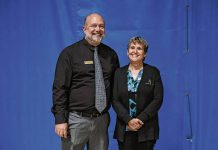Most of us are moved by music, and though some of us don’t want to admit it, music makes us want to move. We use music to motivate us to keep going at the gym or on a run. We jam and rock out to our favorite songs on the radio in the car. We dance with our friends at a club or wedding reception.
But we don’t usually think of dancing to the music at an orchestral concert. Recently at the Erne Auditorium, the Columbus Indiana Philharmonic with guest violinist Susie Park danced its way into the hearts of the audience with an exciting and rousing program of music by Marquez, Beethoven and Tchaikovsky.
The program opened with Danzon No. 2 by Mexican composer Arturo Marquez, with a driving Latin beat that set a rhythmic tone for the evening. With the strings strumming their instruments like guitars and a full range of percussion instruments providing a pulsating beat, the great power of the orchestral ensemble was on prominent display though at times it did cover some intricate piano work by principal keyboardist, Timothy Stephenson.
Special mention must be given to the solo work of Donna Wilson on piccolo and the outstanding performance of trumpeters, Eddie Ludema, principal, and Shannon Walsh, who provided a hot, brassy sound that elicited cheers and whistles from the audience at the conclusion of the number. The players of the orchestra also provided a dramatic exclamation point to the piece with a gesture of raised bows to the delight of the audience.
With the audience already intoxicated with the rhythmic flavor of the evening the audience’s glass was filled to overflowing with Beethoven’s Symphony No. 7. The piece once was described by fellow composer Richard Wagner, who wrote, “this symphony is the apotheosis of the dance itself: it is dance in its highest aspect, the loftiest deed of bodily motion, incorporated into an ideal mold of tone.”
Contrasting with the sheer exuberance of the opening number, here the Philharmonic displayed a buoyant lightness with a rhythmic intimacy and intricacy that would be a challenge to most ensembles of this size but the orchestra handled with ease. Utilizing extreme dynamic contrasts or leaps, from soft passages that were almost inaudible to loud explosions of sound that filled the cavernous auditorium, the orchestra was artfully led by maestro David Bowden whose gestures ranged from literally jumping on his podium to intricate hand motions with barely perceptible movements.
With the audience on the edge of their seats as Bowden masterfully held their applause between the first two movements, the musicians performed the second and third movements with appropriate historical style and as Bowden picked up his baton for the fourth and final movement, raced to a dramatic and heart pounding finish. With the members of the orchestra physically interpreting the accents of the music with their heads and bodies, the piece and the first act came to a triumphant finish with the audience loudly cheering for several minutes as the many soloists in the work and the full orchestra itself were dutifully acknowledged.
The second act brought to the stage the guest artist for the evening, Susie Park, an Australian-born violinist who performed as soloist for Tchaikovsky’s Violin Concerto in D Major, op. 35. Now considered one of Tchaikovsky’s finest concert works, the violin part was once called unplayable and at its debut was called by one critic “music that stinks in the ear.”
This performance by Ms. Park with the ensemble could only be called music that sings in the ear and causes the heart to dance with joy. Her performance was breathtaking with her virtuosic playing at heart racing speed that was both dazzling and emotionally passionate. One could easily close their eyes and be immersed in her subtle phrasing while at the same time overwhelmed by her intense energy.
But to watch her as she played was even more powerful as she twisted her body and literally danced to the music while her face and her eyes conveyed even more emotion. She and Bowden collaborated effortlessly on moments of great nuance in phrasing, dynamics and subtle changes of tempo that were so well executed that at times even they had to smile at the success of their endeavors.
Her performance was so commanding that it would have been easy to almost forget about the orchestra and the role they were playing in this musical alliance. However, they responded to her level of expertise by playing at an extremely high level and seemed to be inspired by her musicianship as evidenced by the visual responses to her solo passages and the intensity of their own music making.
The musical and emotional tension in the composition created by the troubled and tormented composer Tchaikovsky was outstandingly portrayed by this young artist so well supported by this fine orchestra under the masterful tutelage of its strong conductor.
It was a performance long to be remembered and the audience was almost instantly on its feet showering Park with their adoration — and the Philharmonic and Bowden with their grateful appreciation for an evening of brilliant music making. With thunderous applause demanding an encore, Park returned to the stage for a final unaccompanied violin solo of Bach, giving the audience one last chance to be moved by her music mastery.




